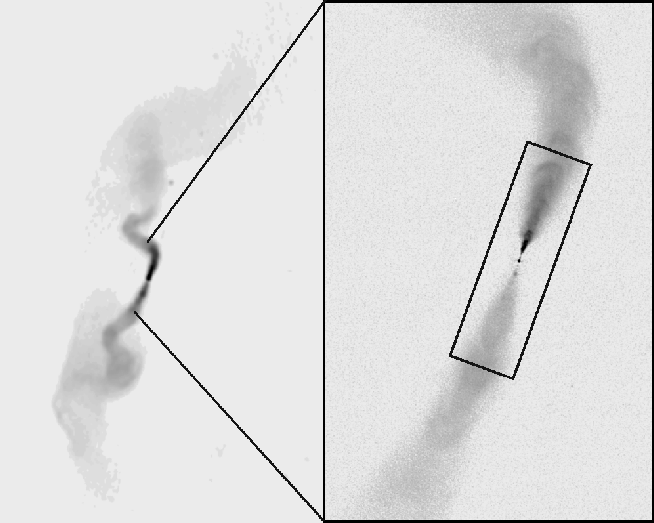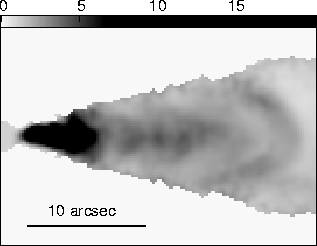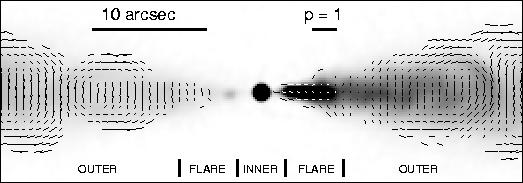 |

 |
The left panel in Fig. 1 shows the large scale structure of 3C31 derived from lower-resolution observations at 1.4 GHz that will be published elsewhere. The jet and counter-jet bend on large scales and form two extensive sinuous plumes. The inner part of our full-resolution 8.4-GHz image is shown in the right panel. Both jets are well collimated and dim for the first 2.5 arcsec from the nucleus, flare and brighten between 2.5 and 8 arcsec and then recollimate, as noted from earlier VLA imaging at 5 GHz (Fomalont et al. 1980). Our assumption of intrinsic symmetry requires that we restrict our analysis to the straight regions of the jets shown in the rectangular box in the right panel of Fig. 1. Within this area, the outer isophotes in the main and counter-jets are indeed very similar. The emission from this region is well-resolved and bright enough to provide strong constraints on the velocities both along and transverse to the jet at about 1300 independent locations.
 |
The systematic differences in brightness and polarization structure
between the jets provide essential clues to the orientation and velocity
field. An image of sidedness ratio, constructed by dividing the I
image by a copy of itself rotated through 180° (in the sense main
jet/counter-jet) is shown in Fig. 2. The ratio is ![]() 5 close to the nucleus and has a mean of
5 close to the nucleus and has a mean of ![]() 13 (with erratic
fluctuations) from 2.5 to 6 arcsec. It drops rapidly between 6 and 8.5 arcsec, thereafter falling smoothly to
13 (with erratic
fluctuations) from 2.5 to 6 arcsec. It drops rapidly between 6 and 8.5 arcsec, thereafter falling smoothly to ![]() at the end of the
modelled region. The ratio at the jet edge is almost always lower than
the on-axis value, but significantly exceeds unity except at distances
from the nucleus
at the end of the
modelled region. The ratio at the jet edge is almost always lower than
the on-axis value, but significantly exceeds unity except at distances
from the nucleus ![]() 20 arcsec.
20 arcsec.

|
Fig. 3 shows the degree of polarization and inferred magnetic field orientation over the inner ±27 arcsec of both jets at 0.75 arcsec resolution. The predominant pattern of the apparent magnetic field directions is to be perpendicular to the jet axis near the centre lines of both jets, and parallel to the outer isophotes (with high degrees of polarization) at both jet edges. A notable exception to this trend occurs between 6 and 10 arcsec from the nucleus at the edges of both jets, where the degree of polarization is very small. There is a polarization asymmetry on small scales: in the bright base of the main jet, the apparent magnetic field lies along the jet axis (as is usual in FRI jets; Bridle & Perley 1984 ), whereas in the equivalent part of the counter-jet, it is transverse. In the outer regions, the degree of transverse-field polarization on-axis is significantly higher in the counter jet.
The jets clearly develop some internal structure (arcs and non-axisymmetric knots) before they reach the large-scale bends (Fig. 1). Similar structures are seen in linear polarization (Fig. 3): most prominently, the apparent magnetic field lies parallel to the intensity ridge lines in the arc-like structures seen on the total intensity images, producing a vortex-like appearance in the magnetic vectors. These features, which account for some tens of per cent of the brightness locally, cannot be modelled assuming that the flow is smooth, axisymmetric and stationary. Together with the large-scale bends in the jet, they effectively set the limits to which we can fit the data.